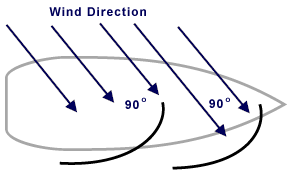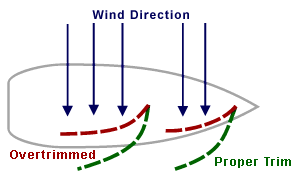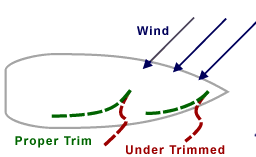Proper sail trim is essential for both control and speed.
The sail should be let out as far as possible without permitting the leading edge to luff, i.e., without fluttering. Luffing is not to be confused with fluttering of the leech (trailing edge of the sail)
If the sail is pulled in while sailing downwind the effective area of the sail is smaller and less force pushes the boat. When sailing downwind, sails are best set perpendicular to the wind as it is shown in the figure below.

Sailing upwind, the luff area of the sail should be parallel to the telltales (pieces of yarn tied to the shrouds). If the sail is pulled in too far while sailing upwind, the flow of air becomes disturbed. This lessens the effectiveness of the airfoil and the boat slows, this is called "over trimmed".

In the illustration above the wind is coming directly across the beam. Here the Sails (red colored) are in too tight resulting in a condition called overtrimmed. The wind is creating a pushing force against the sails but very little lift is created because the air can't flow smoothly across the sail's back side. As a result, the forces tend to heel the boat and push it sideways but do not provide much drive to propel the boat forward. The sails should be eased out (as shown in green color) so that the air can travel across both sides of the sail smoothly. Then they will be able to generate lift and the boat will perform properly. The way to find the right trim is to ease the sails until they begin to luff. (The luff or forward part of the sail will start to puffin.) Then trim back in just enough to fill the sails and stop them from luffing. Another way to correct for an over trimmed situation is to head up. When you get the boat pointed in the right direction, it will accelerate and heel over a bit more. This is due to the increased lift generated by the sails. Correct by heading up if you are beating. If you're reaching in the direction you want to go, ease the sails.

The sails are under trirnmed when they are eased out to far. The sail will luff (flutter) and the boat will slow down, standing up straighter in the water. Here the sails need to be trimmed in, to be filled, in order to get the boat moving. Luffing the sails can be done to slow the boat if desired, but should not be done too much or too long. Sails are damaged by extensive luffing. The diagram above shows the under trimed (in red) and proper trimed (in green) sails.
The jib increases both the sail area and the effectiveness of the mainsail. The space between the jib and the mainsail, called the slot, forces the air to flow faster behind the mainsail. This causes a greater pressure difference on the sail that produces more force or power for sailing. The jib should be trimmed carefully in order not to backwind (luff) the mainsail excessively. The jib, like the main, should be adjusted so that it is just on the verge of luffing. On some jibs, telltales on both sides of the sail about halfway up the luff may be used to judge the air flow around the jib. Best sail trim is when both telltales are flowing back smoothly. If the sail is trimmed in too far, it will stall, and the leeward telltale will not lie smoothly along the sail. If the sail is out too far, the telltale on the windward will not lie smoothly, and the sail will luff.
The mainsail itself can be adjusted with the downhaul, cunningham, outhaul and boom vang. Normally, the downhaul and the outhaul pull out wrinkles in the sail, making a smooth and efficient airfoil. Further tightening flattens the sail, changing it from a low speed airfoil for use in light winds into a high speed airfoil for use in strong winds. The boom vang not only keeps the boom from rising on a reach or run, but also adjusts the curvature of the leech and flattens the mainsail at the same time.
| Contents | 1 | 2 | 3 | 4 | 5 | 6 | 7 | 8 | 9 | 10 | 11 | 12 | 13 | 14 | 15 | 16 | 17 | 18 | 19 |
[Previous Chapter] [Next Chapter]